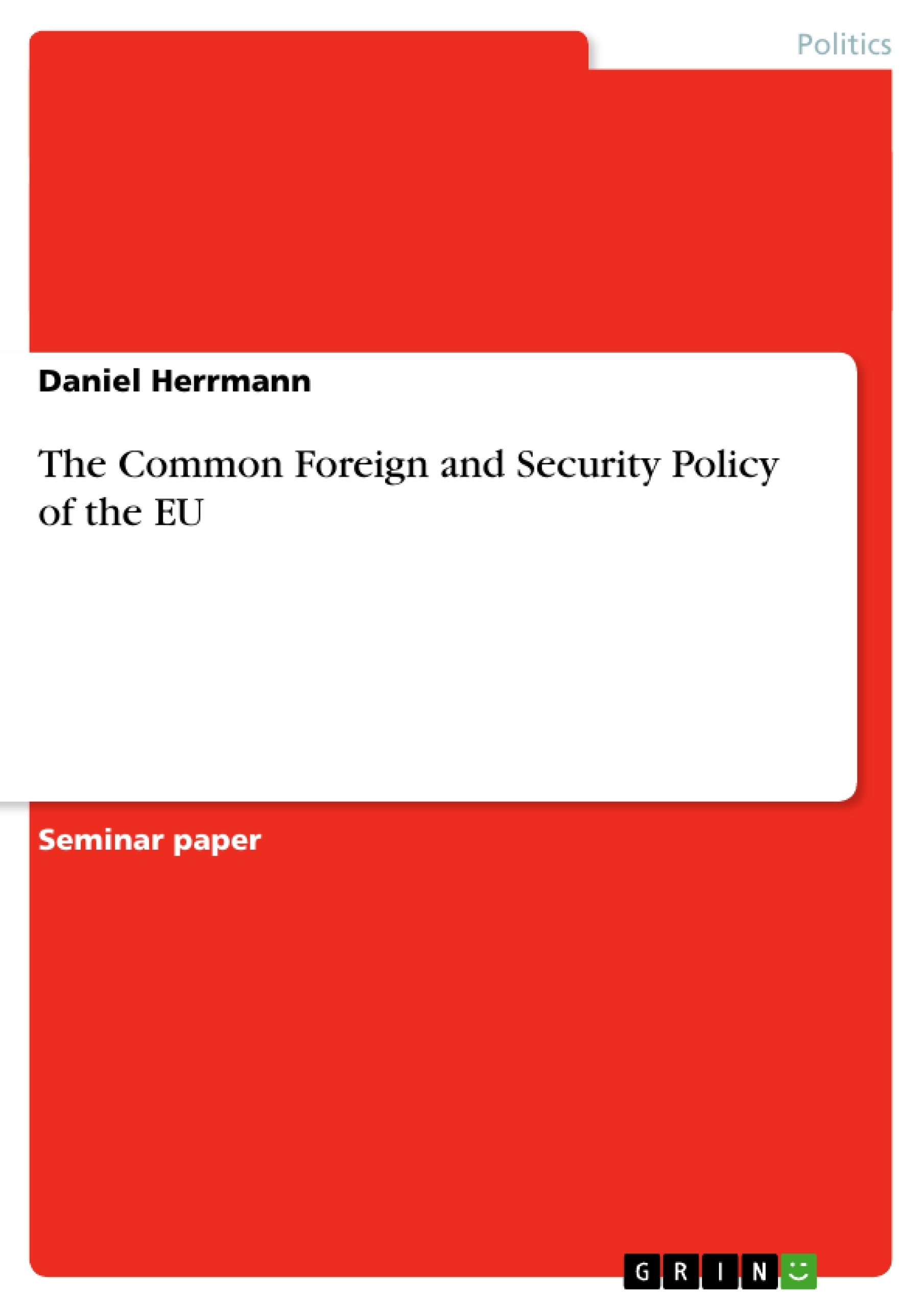What is the Common Foreign Security Policy (CFSP) of the European Union? What are its intentions and goals, how is it situated in the framework of the European Union? How can decisions be made in that context and what influences the outcome of this process? Attempts of explanation will be made, although it is expected that the reader has sufficient knowledge about the history of european cooperation on the fields of foreign and security issues, as this research will start with the foundation of the CFSP in the Treaty on the European Union of Maastricht 1992/93. After investigation of the abilities and concepts of the CFSP the case of Serbia and Montenegro shall be put into focus. What has happened in the region paralell to the development of the CFSP in the decade of 1990 – 2000, affecting this new state. What sort of engagement was imposed by the European Union? Did it have adequate success or was it an overall failure to try and would have been better to leave this matter to the United States “South Eastern European Cooperative Initiative” (SECI)? What was achieved through the Belgrade Agreement of March 2002, a real solution or a sort of ceasefire between the parties? Concluding the two research questions and presenting three different but in fact not so different views on the development of engangement of the European Union in southeastern europe shall then lead into a conclusion dealing with the question wether or not the CFSP and its initiatives can be a tool to improve the position of the EU in the world context and as a regional actor.
Inhaltsverzeichnis (Table of Contents)
- Introduction
- Section I: The Common Foreign and Security Policy of the European Union
- 1.1: History and targets of the CFSP
- 1.2: Important Articles and Titles of the Treaty on European Union referring to the CFSP
- 1.3: Structure of the CFSP - problems and ways within decision structure
- 1.3.1 The institutions affected by the CFSP
- 1.3.2. The decision making structure of the CFSP
- 1.4: Identitiy and interests of member states
- 1.4.1 The "Grande Nation": France
- 1.4.2. The European Developer: Germany
- 1.5: Summary
- Section II: The EU's role in conflict resolution in the former Yugoslavia on the example of Serbia and Montenegro
- 2.1: Marks in the decade of war in the former Rebulic of Yugoslavia with special importance to the parts of Serbia and Montenegro
- 2.2: Attempts and engagement of the EU in conflict resolution in Serbia and Montenegro
- 2.3: The Belgrade Agreement
- Section III: Dimension of EU's foreign policy in the framework of SouthEastern Europe
- 3.1: Focus on the results of the SAA for Serbia and Montenegro
- 3.1.1 Gergana Noutcheva and Michel Huysseune:
- 3.1.2. Jadranko Prlic: A new european future for the Balkans?
- 3.1.3. Rafael Biermann: From stabilization to integration
- 3.2: Conclusion
- 3.1: Focus on the results of the SAA for Serbia and Montenegro
- Literature
Zielsetzung und Themenschwerpunkte (Objectives and Key Themes)
This research paper investigates the Common Foreign and Security Policy (CFSP) of the European Union, examining its objectives, structure, and effectiveness in conflict resolution. It focuses specifically on the EU's role in the conflict resolution process in Serbia and Montenegro, analyzing the impact of the CFSP on the region.
- The history and development of the CFSP
- The structure and decision-making processes of the CFSP
- The EU's role in conflict resolution in the former Yugoslavia, particularly in Serbia and Montenegro
- The effectiveness of the CFSP in promoting stability and security in southeastern Europe
- The potential of the CFSP to enhance the EU's position as a regional and global actor.
Zusammenfassung der Kapitel (Chapter Summaries)
The paper begins with an overview of the CFSP, tracing its historical development and outlining its key aims and objectives. It discusses the CFSP's institutional structure and decision-making processes, including the involvement of various EU institutions. The chapter also examines the impact of national identities and interests, focusing on the roles of France and Germany in shaping the CFSP.
The second chapter examines the EU's role in conflict resolution in the former Yugoslavia, specifically focusing on Serbia and Montenegro. It explores the impact of the decade-long conflict on the region and analyzes the EU's attempts to engage in conflict resolution efforts. The chapter discusses the significance of the Belgrade Agreement and its impact on the situation in Serbia and Montenegro.
The third chapter delves into the EU's foreign policy approach towards southeastern Europe, specifically analyzing the results of the Stabilization and Association Agreement (SAA) for Serbia and Montenegro. It examines different perspectives on the EU's involvement in the region, including views on the potential for a "new European future" for the Balkans and the transition from stabilization to integration.
Schlüsselwörter (Keywords)
The primary keywords and focus topics of this research paper include the Common Foreign and Security Policy (CFSP), European Union, conflict resolution, Serbia, Montenegro, former Yugoslavia, southeastern Europe, Stabilization and Association Agreement (SAA), regional and global actor.
- Quote paper
- Daniel Herrmann (Author), 2005, The Common Foreign and Security Policy of the EU, Munich, GRIN Verlag, https://www.grin.com/document/34469




